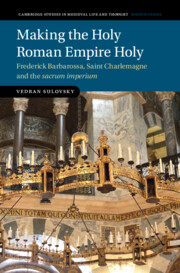 Making the Holy Roman Empire Holy
Making the Holy Roman Empire Holy Published online by Cambridge University Press: 16 May 2024
The conclusion draws upon the findings of all the chapters to argue that Barbarossa scholars had often studied more a construct of post-Kulturkampf Germany than the medieval emperor himself. Rather than a sacraliser of the state who teamed up with Reichskanzler Rainald of Dassel (a stand-in for Otto von Bismarck) in order to hammer the Papacy into submission, Frederick I was a ruler determined to restore the greatness of the Empire by many different means, including papal and Arab alliances. This has been overlooked because of the dearth of sources for the later part of his reign, and because of the profound misunderstanding of Frederick’s Aquensian projects. By dismantling the historiography in an archaeological way, Sulovsky restores the connections apparent in the sources, and makes it clear that the increasing Romanisation of the Empire had radical consequences for authority and its expressions, both for the pope and the emperor. Therefore, much of what was described as a deliberate sacralisation of the Empire in opposition to the Papac, was in fact its gradual Romanisation. This was not a project spearheaded by German court, but by the self-conscious Italians, who wanted a Roman emperor to represent them, and not a German king.
To save this book to your Kindle, first ensure no-reply@cambridge.org is added to your Approved Personal Document E-mail List under your Personal Document Settings on the Manage Your Content and Devices page of your Amazon account. Then enter the ‘name’ part of your Kindle email address below. Find out more about saving to your Kindle.
Note you can select to save to either the @free.kindle.com or @kindle.com variations. ‘@free.kindle.com’ emails are free but can only be saved to your device when it is connected to wi-fi. ‘@kindle.com’ emails can be delivered even when you are not connected to wi-fi, but note that service fees apply.
Find out more about the Kindle Personal Document Service.
To save content items to your account, please confirm that you agree to abide by our usage policies. If this is the first time you use this feature, you will be asked to authorise Cambridge Core to connect with your account. Find out more about saving content to Dropbox.
To save content items to your account, please confirm that you agree to abide by our usage policies. If this is the first time you use this feature, you will be asked to authorise Cambridge Core to connect with your account. Find out more about saving content to Google Drive.